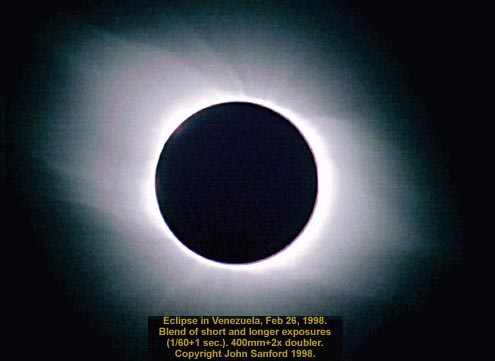Credit & Copyright: J. Sanford
Explanation:
On February 26th, it was dark during the day. This total solar eclipse was the last visible from the Americas
for this millennium.
A total solar eclipse is
exciting partly because it is so short.
Were
Earth's Moon farther away, no total eclipse
would occur at all because the Moon
would appear too small to block out all of the
Sun.
Were the Moon much closer to the Earth,
the eclipse would last much longer.
Oddly, the Sun and Moon have almost
exactly the same angular size.
Even for
well located observers, this
creates at most only a
very few minutes of totality
before the Moon's shadow moves away.
During a
total solar eclipse in 1919,
these few minutes were long enough for scientists to
determine that the Sun's gravity bends light from the stars behind it,
dramatically confirming the accuracy of a
new theory of gravity postulated over 80 years ago.
1999 2000 2001 2002 2003 2004 2005 2006 2007 2008 2009 2010 2011 2012 2013 2014 2015 2016 2017 2018 2019 2020 2021 2022 2023 2024 2025 |
Январь Февраль Март Апрель Май Июнь Июль Август Сентябрь Октябрь Ноябрь Декабрь |
NASA Web Site Statements, Warnings, and Disclaimers
NASA Official: Jay Norris. Specific rights apply.
A service of: LHEA at NASA / GSFC
& Michigan Tech. U.
|
Публикации с ключевыми словами:
Sun - Total eclipse - полное солнечное затмение - Общая теория относительности - Луна - Солнце
Публикации со словами: Sun - Total eclipse - полное солнечное затмение - Общая теория относительности - Луна - Солнце | |
См. также:
Все публикации на ту же тему >> | |
